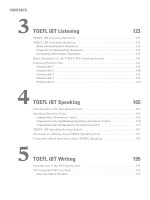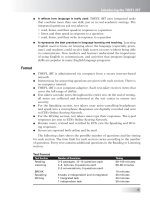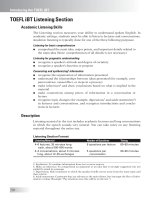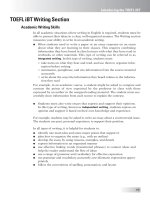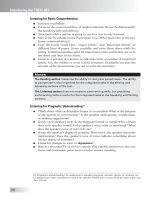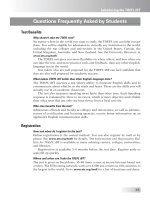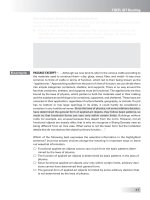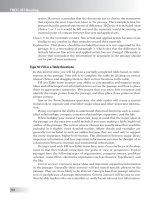The official guide to the toefl ibt third edition part 30 pptx
Bạn đang xem bản rút gọn của tài liệu. Xem và tải ngay bản đầy đủ của tài liệu tại đây (123.55 KB, 7 trang )
This page intentionally left blank
Introduction to the Writing Section
There are two tasks in the Writing section of the TOEFL iBT test: an Integrated
Writing Task and an Independent Writing Task.
The Integrated Writing Task comes first because it requires some listening,
and when you are taking the real TOEFL iBT, you will be wearing headphones.
When you finish the Integrated Writing Task, which takes about 20 minutes, you
may take the headphones off to work on the Independent Writing Task. You will
then have 30 minutes to complete the Independent Writing Task.
This chapter discusses each of the writing tasks in detail and the scoring cri-
teria that raters will use to evaluate your writing. It includes samples of each task,
sample responses to each task, and specific advice on how to approach writing
your own response.
For both the writing tasks on the TOEFL iBT, the people evaluating your writ-
ing recognize that your response is a first draft. You are not expected to produce
a well-researched, comprehensive essay about a highly specific, specialized topic.
You can receive a high score with an essay that contains some errors.
The Integrated Writing Task
You will read a passage about an academic topic for three minutes, and then you
will hear a short lecture related to the topic. Then you will be asked to summarize
the points in the listening passage and explain how they relate to specific points
in the reading passage.
This task gives you the opportunity to demonstrate your ability to show that
you can communicate in writing about academic information you have read and
listened to.
TOEFL iBT
Writing
g The format of TOEFL iBT Writing questions
g How your written responses are evaluated
g Tips for answering each Writing question type
g Strategies for raising your TOEFL Writing score
Read this
chapter
to learn
195
5
Example
A reading passage like the following will appear on your computer screen. You
will have 3 minutes to read the passage.
In many organizations, perhaps the best way to approach certain new projects
is to assemble a group of people into a team. Having a team of people attack
a project offers several advantages. First of all, a group of people has a wider
range of knowledge, expertise, and skills than any single individual is likely
to possess. Also, because of the numbers of people involved and the greater
resources they possess, a group can work more quickly in response to the task
assigned to it and can come up with highly creative solutions to problems and
issues. Sometimes these creative solutions come about because a group is
more likely to make risky decisions that an individual might not undertake. This
is because the group spreads responsibility for a decision to all the members
and thus no single individual can be held accountable if the decision turns out
to be wrong.
Taking part in a group process can be very rewarding for members of the team.
Team members who have a voice in making a decision will no doubt feel better
about carrying out the work that is entailed by that decision than they might
doing work that is imposed on them by others. Also, the individual team
member has a much better chance to “shine,” to get his or her contributions
and ideas not only recognized but recognized as highly significant, because a
team’s overall results can be more far-reaching and have greater impact than
what might have otherwise been possible for the person to accomplish or
contribute working alone.
Then you will hear:
Narrator
Now listen to part of a lecture on the topic you just read about.
Professor
Now I want to tell you about what one company found when it decided that it would
turn over some of its new projects to teams of people, and make the team responsible
for planning the projects and getting the work done. After about six months, the com-
pany took a look at how well the teams performed.
On virtually every team, some members got almost a “free ride” . . . they didn’t
contribute much at all, but if their team did a good job, they nevertheless benefited
from the recognition the team got. And what about group members who worked es-
pecially well and who provided a lot of insight on problems and issues? Well . . . the
recognition for a job well done went to the group as a whole, no names were named.
So it won’t surprise you to learn that when the real contributors were asked how they
felt about the group process, their attitude was just the opposite of what the reading
predicts.
Another finding was that some projects just didn’t move very quickly. Why? Be-
cause it took so long to reach consensus; it took many, many meetings to build the
agreement among group members about how they would move the project along. On
196
TOEFL iBT Writing
the other hand, there were other instances where one or two people managed to be-
come very influential over what their group did. Sometimes when those influencers
said “That will never work” about an idea the group was developing, the idea was
quickly dropped instead of being further discussed. And then there was another occa-
sion when a couple influencers convinced the group that a plan of theirs was “highly
creative.” And even though some members tried to warn the rest of the group that the
project was moving in directions that might not work, they were basically ignored by
other group members. Can you guess the ending to this story? When the project
failed, the blame was placed on all the members of the group.
The reading passage will then reappear on your computer screen, along with the fol-
lowing directions and writing task:
You have 20 minutes to plan and write your response. Your response will be
judged on the basis of the quality of your writing and on how well your
response presents the points in the lecture and their relationship to the reading
passage. Typically, an effective response will be 150 to 225 words.
Summarize the points made in the lecture you just heard, explaining how they cast
doubt on points made in the reading.
The writing clock will then start a countdown for 20 minutes of writing time.
How the Task Is Phrased
If the lecture challenges the information in the reading passage, the writing task
will usually be phrased in one of the following ways:
b
Summarize the points made in the lecture, being sure to explain how
they cast doubt on specific points made in the reading passage.
b
Summarize the points made in the lecture, being sure to explain how
they challenge specific claims/arguments made in the reading passage.
b
Summarize the points made in the lecture, being sure to specifically
explain how they answer the problems raised in the reading passage.
If the lecture supports or strengthens the information in the reading passage, the
writing task will usually be phrased in one of the following ways:
b
Summarize the points made in the lecture, being sure to specifically
explain how they support the explanations in the reading passage.
b
Summarize the points made in the lecture, being sure to specifically
explain how they strengthen specific points made in the reading passage.
197
TOEFL iBT Writing
198
TOEFL iBT WRITING
Strategies for Raising Your Score on the
Integrated Writing Task
As you read:
b
Take notes on your scratch paper.
b
Look for the main idea of the reading passage. The main idea often has to
do with some policy or practice or some position on an issue. Or it may
have to do with proposing some overall hypothesis about the way some
process or procedure works or should work or how some natural phe-
nomenon is believed to work.
b
See how this main idea is evaluated or developed. Usually it will be devel-
oped in one of two ways:
1. Arguments or explanations are presented that support the main posi-
tion; for example, why there are good reasons to believe that some pol-
icy or practice will be beneficial or prove useful or advisable or perhaps
why it has been a good thing in the past.
2. Arguments or explanations or problems are brought up concerning why
some policy or practice or position or hypothesis will not or does not
work or will not be useful or advisable.
b
You do not need to memorize the reading passage. It will reappear on
your computer screen when it is time to write.
b
Note points in the passage that either support the main idea or provide
reasons to doubt the main idea. Typically the main idea will be developed
with three points.
As you listen:
b
Take notes on your scratch paper.
b
Listen for information, examples, or explanations that make points in the
reading passage seem wrong or less convincing or even untrue. For
instance, in the example just given, the reading passage says that working
in teams is a good thing because it gives individuals a chance to stand out.
But the lecture says that often everyone gets equal credit for the work of a
team, even if some people do not do any work at all. The reading says that
work proceeds quickly on a team because there are more people involved,
and each person brings his or her expertise. But the lecture completely
contradicts this claim by stating that it may take a long time for the group
to reach consensus. The lecture brings up the idea that the whole team
can be blamed for a failure when the fault lies with only a few team mem-
bers. This casts doubt on the claim in the reading that teams can take
risks and be creative because no one individual is held accountable.
199
TOEFL iBT WRITING
As you write your response:
b
You may take off your headset if you wish. You will not need your headset
for the remainder of the TOEFL iBT test.
b
Before you start writing, briefly reread the passage, consult your notes,
and make a very brief outline of the points you wish to make. You can
write this outline on your scratch paper or draw lines between the notes
you took on the reading and the notes you took on the lecture. You can
even type your outline and notes right into the answer area and then
replace these by sentences and paragraphs as you compose your response.
b
Remember that you are NOT being asked for your opinion. You ARE
being asked to explain how the points in the listening relate to points in
the reading.
b
Write in full English sentences. You can write either one long paragraph
or a series of short paragraphs listing the points of opposition between the
reading and the lecture. Occasional language errors will not count against
you as long as they do not cause you to misrepresent the meaning of
points from the reading and the lecture.
b
Remember that your job is to select the important information from the
lecture and coherently and accurately present this information in relation
to the relevant information from the reading. Your response should con-
tain the following:
1. The specific ideas, explanations, and arguments in the lecture that
oppose or challenge points in the reading.
2. Coherent and accurate presentations of each point that you make; that
is, the language you use should make sense and should accurately
reflect the ideas presented in the lecture and the reading.
3. A clear, coherent structure that enables the reader to understand what
points in the lecture relate to what points in the reading.
b
Suggested length is between 150 and 225 words. You will not be penalized
if you write more, so long as what you write answers the question.
b
CAUTION: You will receive a score of zero if all you do is copy words from
the reading passage. You will receive a score of 1 if you write ONLY about
the reading passage. To respond successfully, you must do your best to write
about the ways the points in the lecture are related to specific points in the
reading.
Integrated Writing Scoring Rubric
Here is the official Scoring Guide used by raters when they read the Integrated
Writing Task.
Score Task Description
5 A response at this level successfully selects the important information from the
lecture and coherently and accurately presents this information in relation to
the relevant information presented in the reading. The response is well organ-
ized, and occasional language errors that are present do not result in inaccurate
or imprecise presentation of content or connections.
4 A response at this level is generally good in selecting the important information
from the lecture and in coherently and accurately presenting this information in
relation to the relevant information in the reading, but it may have minor omis-
sion, inaccuracy, vagueness, or imprecision of some content from the lecture or
in connection to points made in the reading. A response is also scored at this
level if it has more frequent or noticeable minor language errors, as long as
such usage and grammatical structures do not result in anything more than an
occasional lapse of clarity or in the connection of ideas.
3 A response at this level contains some important information from the lecture
and conveys some relevant connection to the reading, but it is marked by one or
more of the following:
b
Although the overall response is definitely oriented to the task, it conveys
only vague, global, unclear, or somewhat imprecise connection of the points
made in the lecture to points made in the reading.
b
The response may omit one major key point made in the lecture.
b
Some key points made in the lecture or the reading, or connections between
the two, may be incomplete, inaccurate, or imprecise.
b
Errors of usage and/or grammar may be more frequent or may result in no-
ticeably vague expressions or obscured meanings in conveying ideas and con-
nections.
200
TOEFL iBT Writing

